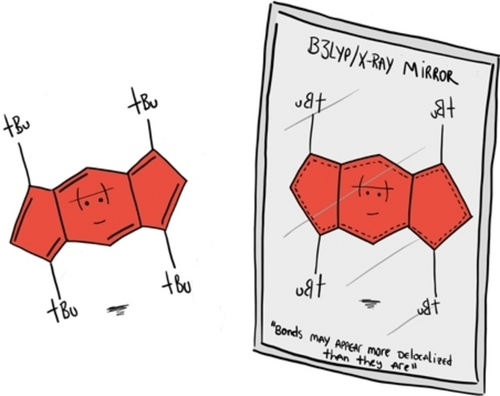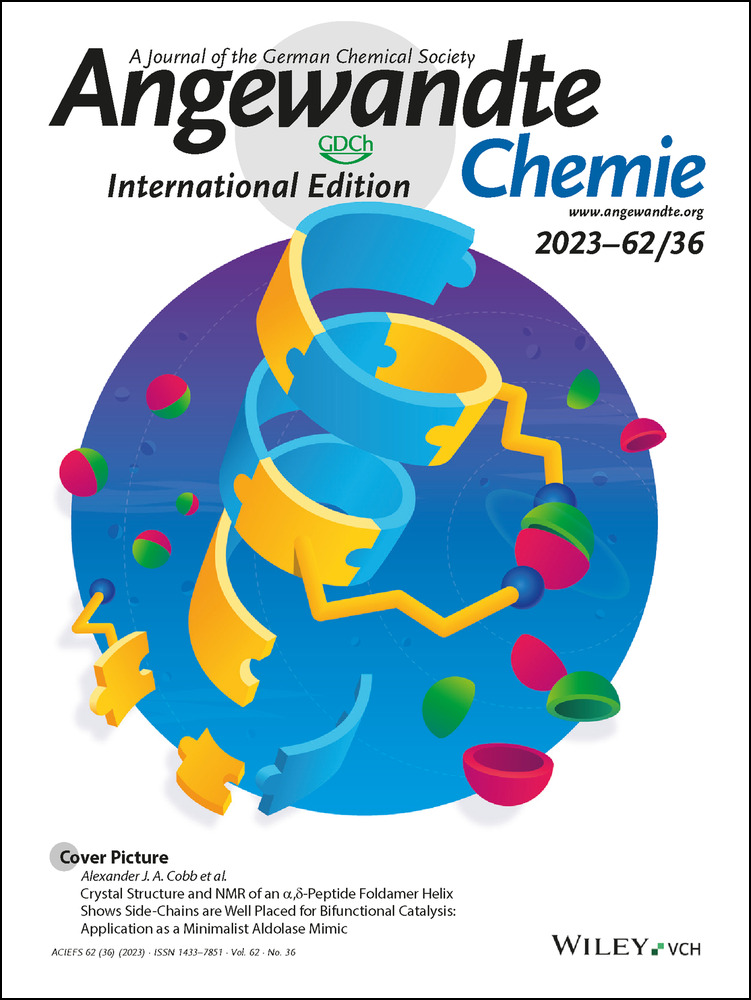Tetra-tert-butyl-s-indacene is a Bond-Localized C2h Structure and a Challenge for Computational Chemistry
Dr. Lucas J. Karas
Department of Chemistry, University of Houston, Houston, TX 77204 USA
These authors contributed equally to this work.
Search for more papers by this authorDr. Said Jalife
Department of Chemistry, University of Houston, Houston, TX 77204 USA
These authors contributed equally to this work.
Search for more papers by this authorDr. Renan V. Viesser
Department of Chemistry, University of Houston, Houston, TX 77204 USA
Search for more papers by this authorJoão V. Soares
Department of Chemistry, University of Houston, Houston, TX 77204 USA
Search for more papers by this authorCorresponding Author
Prof. Michael M. Haley
Department of Chemistry & Biochemistry and the Materials Science Institute, University of Oregon, Eugene, OR 97403-1253 USA
Search for more papers by this authorCorresponding Author
Prof. Judy I. Wu
Department of Chemistry, University of Houston, Houston, TX 77204 USA
Search for more papers by this authorDr. Lucas J. Karas
Department of Chemistry, University of Houston, Houston, TX 77204 USA
These authors contributed equally to this work.
Search for more papers by this authorDr. Said Jalife
Department of Chemistry, University of Houston, Houston, TX 77204 USA
These authors contributed equally to this work.
Search for more papers by this authorDr. Renan V. Viesser
Department of Chemistry, University of Houston, Houston, TX 77204 USA
Search for more papers by this authorJoão V. Soares
Department of Chemistry, University of Houston, Houston, TX 77204 USA
Search for more papers by this authorCorresponding Author
Prof. Michael M. Haley
Department of Chemistry & Biochemistry and the Materials Science Institute, University of Oregon, Eugene, OR 97403-1253 USA
Search for more papers by this authorCorresponding Author
Prof. Judy I. Wu
Department of Chemistry, University of Houston, Houston, TX 77204 USA
Search for more papers by this authorGraphical Abstract
Abstract
Whether tetra-tert-butyl-s-indacene is a symmetric D2h structure or a bond-alternating C2h structure remains a standing puzzle. Close agreement between experimental and computed proton chemical shifts based on minima structures optimized at the M06-2X, ωB97X-D, and M11 levels confirm a bond-localized C2h symmetry, which is consistent with the expected strong antiaromaticity of TtB-s-indacene.
Open Research
Data Availability Statement
The data that support the findings of this study are available in the supplementary material of this article.
Supporting Information
As a service to our authors and readers, this journal provides supporting information supplied by the authors. Such materials are peer reviewed and may be re-organized for online delivery, but are not copy-edited or typeset. Technical support issues arising from supporting information (other than missing files) should be addressed to the authors.
| Filename | Description |
|---|---|
| anie202307379-sup-0001-misc_information.pdf2 MB | Supporting Information |
Please note: The publisher is not responsible for the content or functionality of any supporting information supplied by the authors. Any queries (other than missing content) should be directed to the corresponding author for the article.
References
- 1K. Hafner, Pure Appl. Chem. 1982, 54, 939–956.
- 2K. Hafner, B. Stowasser, H.-P. Krimmer, S. Fischer, M. C. Böhm, H. J. Lindner, Angew. Chem. Int. Ed. 1986, 25, 630–632.
- 3E. Heilbronner, Z.-Z. Yang, Angew. Chem. Int. Ed. 1987, 26, 360–362.
- 4J. D. Dunitz, C. Krüger, H. Irngartinger, E. F. Maverick, Y. Wang, M. Nixdorf, Angew. Chem. Int. Ed. 1988, 27, 387–389.
- 5C. Gellini, G. Cardini, P. R. Salvi, G. Marconi, K. Hafner, J. Phys. Chem. 1993, 97, 1286–1293.
- 6R. H. Hertwig, M. C. Holthausen, W. Koch, Z. B. Maksić, Angew. Chem. Int. Ed. 1994, 33, 1192–1194.
- 7R. R. Hertwig, M. C. Holthausen, W. Koch, Z. B. Maksí, Int. J. Quantum Chem. 1995, 54, 147–159.
- 8M. Nendel, B. Goldfuss, K. N. Houk, K. Hafner, J. Mol. Struct. 1999, 461–462, 23–28.
- 9L. Moroni, C. Gellini, P. R. Salvi, J. Mol. Struct. 2004, 677, 1–5.
- 10K. Hafner, K. H. Häfner, C. König, M. Kreuder, G. Ploss, G. Schulz, E. Sturm, K. H. Vöpel, Angew. Chem. Int. Ed. 1963, 2, 123–134.
10.1002/anie.196301231 Google Scholar
- 11T. Nakajima, T. Saijo, H. Yamaguchi, Tetrahedron 1964, 20, 2119–2124.
- 12R. D. Brown, J. Chem. Soc. 1951, 2391–2394.
- 13M. Bühl, P. v. R. Schleyer, J. Am. Chem. Soc. 1992, 114, 477–491.
- 14C. S. Wannere, K. W. Sattelmeyer, H. F. Schaefer, III, P. v R. Schleyer, Angew. Chem. Int. Ed. 2004, 43, 4200–4206.
- 15C. H. Choi, M. Kertesz, J. Chem. Phys. 1998, 108, 6681–6688.
- 16K. K. Baldridge, J. S. Siegel, Angew. Chem. Int. Ed. 1997, 36, 745–748.
- 17R. Gershoni-Poranne, A. Stanger, Chem. Eur. J. 2014, 20, 5673–5688.
- 18H. M. Sulzbach, P. v. R. Schleyer, H. Jiao, Y. Xie, H. F. Schaefer, III, J. Am. Chem. Soc. 1995, 117, 1369–1373.
- 19H. M. Sulzbach, H. F. Schaefer, III, W. Klopper, H. P. Lüthi, J. Am. Chem. Soc. 1996, 118, 3519–3520.
- 20R. A. King, T. D. Crawford, J. F. Stanton, H. F. Schaefer, III, J. Am. Chem. Soc. 1999, 121, 10788–10793.
- 21I. Casademont-Reig, R. Guerrero-Avilés, E. Ramos-Cordoba, M. Torrent-Sucarrat, E. Matito, Angew. Chem. Int. Ed. 2021, 60, 24080–24088.
- 22J.-R. Deng, D. Bradley, M. Jirásek, H. L. Anderson, M. D. Peeks, Angew. Chem. Int. Ed. 2022, 61, e202201231.
- 23I. Casademont-Reig, L. Soriano-Agueda, E. Ramos-Cordoba, M. Torrent-Sucarrat, E. Matito, Angew. Chem. Int. Ed. 2022, 61, e202206836.
- 24M. D. Peeks, T. D. W. Claridge, H. L. Anderson, Nature 2017, 541, 200–203.
- 25P. Mori-Sánchez, A. J. Cohen, W. Yang, Phys. Rev. Lett. 2008, 100, 146401.
- 26S.-J. Jhang, J. Pandidurai, C.-P. Chu, H. Miyoshi, Y. Takahara, M. Miki, H. Sotome, H. Miyasaka, S. Chatterjee, R. Ozawa, Y. Ie, I. Hisaki, C.-L. Tsai, Y.-J. Cheng, Y. Tobe, J. Am. Chem. Soc. 2023, 145, 4716–4729.
- 27J. E. Barker, T. W. Price, L. J. Karas, R. Kishi, S. N. MacMillan, L. N. Zakharov, C. J. Gómez-García, J. I. Wu, M. Nakano, M. M. Haley, Angew. Chem. Int. Ed. 2021, 60, 22385–22392.
- 28K. Hafner, H. U. Süss, Angew. Chem. Int. Ed. 1973, 12, 575–577.
- 29T. Gazdag, P. J. Mayer, P. P. Kalapos, T. Holczbauer, O. El Bakouri, G. London, ACS Omega 2022, 7, 8336–8349.
- 30P. J. Mayer, G. London, Org. Lett. 2023, 25, 42–46.
- 31T. Xu, Y. Han, Z. Shen, X. Hou, Q. Jiang, W. Zeng, P. W. Ng, C. Chi, J. Am. Chem. Soc. 2021, 143, 20562–20568.
- 32National Institute of Advanced Industrial Science and Technology, SDBSWeb, 2023, https://sdbs.db.aist.go.jp.
- 33T. Nishinaga, T. Ohmae, K. Aita, M. Takase, M. Iyoda, T. Arai, Y. Kunugi, Chem. Commun. 2013, 49, 5354–5356.
- 34C. Liu, S. Xu, W. Zhu, X. Zhu, W. Hu, Z. Li, Z. Wang, Chem. Eur. J. 2015, 21, 17016–17022.
- 35C. K. Frederickson, B. D. Rose, M. M. Haley, Acc. Chem. Res. 2017, 50, 977–987.
- 36Z. Jin, Z.-F. Yao, K. P. Barker, J. Pei, Y. Xia, Angew. Chem. Int. Ed. 2019, 58, 2034–2039.
- 37J. Wang, M. Chu, J.-X. Fan, T.-K. Lau, A.-M. Ren, X. Lu, Q. Miao, J. Am. Chem. Soc. 2019, 141, 3589–3596.
- 38C. K. Frederickson, L. N. Zakharov, M. M. Haley, J. Am. Chem. Soc. 2016, 138, 16827–16838.
- 39J. J. Dressler, M. M. Haley, J. Phys. Org. Chem. 2020, 33, e4114.
- 40T. Kawase, J.-i. Nishida, Chem. Rec. 2015, 15, 1045–1059.
- 41B. Esser, J. S. Wössner, M. Hermann, Synlett 2022, 33, 737–753.
- 42T. Kawase, T. Fujiwara, C. Kitamura, A. Konishi, Y. Hirao, K. Matsumoto, H. Kurata, T. Kubo, S. Shinamura, H. Mori, E. Miyazaki, K. Takimiya, Angew. Chem. Int. Ed. 2010, 49, 7728–7732.
- 43J. L. Marshall, K. Uchida, C. K. Frederickson, C. Schütt, A. M. Zeidell, K. P. Goetz, T. W. Finn, K. Jarolimek, L. N. Zakharov, C. Risko, R. Herges, O. D. Jurchescu, M. M. Haley, Chem. Sci. 2016, 7, 5547–5558.
- 44A. M. Zeidell, L. Jennings, C. K. Frederickson, Q. Ai, J. J. Dressler, L. N. Zakharov, C. Risko, M. M. Haley, O. D. Jurchescu, Chem. Mater. 2019, 31, 6962–6970.
- 45R. Breslow, F. W. Foss Jr, J. Phys. Condens. Matter 2008, 20, 374104.
- 46T. A. Su, M. Neupane, M. L. Steigerwald, L. Venkataraman, C. Nuckolls, Nat. Rev. Mater. 2016, 1, 16002.





